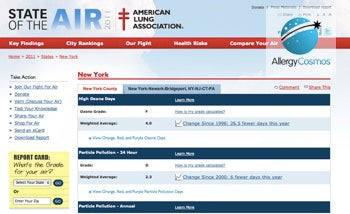Air pollution in a city is an increasingly global issue, with people travelling or relocating further afield. If you are planning a trip, or a move, you'll want to take account of what levels of pollutants like particulate matter (PM) and ozone are like in your destination city – especially if you suffer with asthma or another health problem that is exacerbated by exposure to pollution. Which raises the question what is the best way of measuring air pollution.
For instance, California may sound like a dream destination, but in fact, measuring air pollution in the Central Valley has just recorded the worst US air quality for several years. Apparently, dry stagnant air in recent weeks has caused levels of ozone and PM to soar between the towns of Modesto and Bakersfield, breaking federal standards on most days.
So it was no surprise to learn from the American Lung Association's State of Air report that Bakersfield is America's pollution hot spot, with asthma rates three times the national average. Measuring air pollution and checking the data shows that the annual average PM levels are 23 micrograms per cubic metre. The World Health Organization guideline maximum values are 20 for PM10s, and 10 for the smaller, and more dangerous, PM2.5s. By contrast, PM levels in America's cleanest city, Cheyenne, Wyoming, is just 4.0 micrograms per cubic metre.
Of course, the reasons for these wide differences are many and complex. But what stands out is the ease of access to this important data regarding measuring air pollution from the American Lung Association's website. You can just key in your city or postcode and immediately find out where the location stands with regard to ozone and PM pollution, with health risks to people with asthma and other conditions clearly explained. Do we have an equivalent site in the UK? I think not (which is not to take anything away from our excellent network of air pollution monitoring stations – the UK data is there, and of high quality too).
Ideally, there'd be easily accessible data on measuring air pollution and urban air pollution available all around the world so people can make informed decisions about travel and relocation. A recent report suggests that China is, at last, beginning to take note of this 'need to know'. Beijing has been notorious for it's smogs and the air pollution problem is beginning to threaten the country's status as an emerging economic and political power. After all, who will want to locate to a country where urban air pollution threatens your heart and lung health? But now an announcement on the Beijing Council's website says they will publish hourly air quality reports based upon PM2.5s, having previously focused upon PM10 pollution only. There are also to be new national air quality standards which, according to China's Ministry of Environmental Protection, will include PM2.5 data. The move has been forced, apparently, by data flying around the world on Twitter and on blogs which have shamed the Chinese government into acting. It's to be hoped the more disclosure on the internet (whether from professional organisations or from individuals) will help clean up the air worldwide – from California to China.
To find out how to protect yourself from air pollution, visit our Air Testing Information Page.




